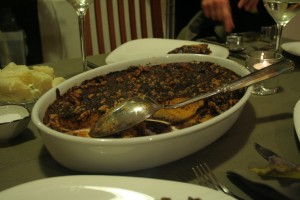Posts Tagged ‘latin kitchen’
Alexia’s Pastelón11.29.09
 This is the moment you’ve been waiting for.
This is the moment you’ve been waiting for.
Throughout the past 5 days, I’ve gotten many requests for this recipe. Although we are now in the December holiday territory, I urge you to make this sweet potato casserole, or pastelón in Dominican. I got the recipe from my cousin Alexia whom I love with all my heart.(gracias alexia!) Now, it is in your hands my friends. All I can say is that once you make this, prepare to be loved, your holidays will never be quite the same again.
Alexia’s Thanksgiving Pastelón
3 cups mashed sweet potatoes
1 cup sugar
½ cup butter
2 eggs
1 teaspoon vanilla*
½ can of evaporated milk
Ground cinnamon*
Pancake syrup*
Peal the sweet potatoes, cut in quarters and boil in salted water for approx 30 minutes or until soft. Drain and mash slowly with a fork. Add the butter, sugar, evaporated milk, vanilla, cinnamon, maple syrup and the egg yolks.
Beat the egg whites and fold in the mixture. Place in baking dish.
Cover with the topping below.
Topping:
½ cup brown sugar
¼ cup all purpose flour
2 1/2 teaspoons butter (hard)
½ cup chopped walnuts
Ground cinnamon
Bake at 350F for approx. 30 minutes.
* Means: “al ojo” or approximate measurements
Marshmallow woman
When you think of Thanksgiving, what is the first thing that comes to mind? For me it’s a can of jellied cranberry, which I thought was the best cranberry sauce in the world. It is when I moved to the northeastern U.S. that I suddenly started thinking twice about it, and eventually got more snobby with my cranberry sauce, choosing more natural interpretations that could be traced back to the actual fruit. What I finally realized was that what I had been serving with turkey all those years, was a far cry from the deep burgundy sauce prepared in kitchens all over the country with sugar, water, spices and of course cranberries.
In the Dominican Republic, unless you’re somehow linked to the U.S.(have family here, have studied here, have an American spouse, etc), Thanksgiving is not a popular holiday. In my home though, the celebration was welcome every year. Mom instituted the tradition after celebrating it herself with her own family. Although the stories were always nebulous, I gathered that her father, my grandfather, had lived in Puerto Rico and had himself adopted the tradition.
Decades later, my kitchen in Santo Domingo buzzed whenever Turkey day would come along. My aunt Tiita took over one of the counters, mixing her secret “Russian” potato salad adding a little of this and a little of that until it was just perfect. Mom pulled out the glistening golden turkey for one last baste. Plantain pasteles filled with shredded chicken boiled in a huge pot. Piping hot rice with kidney beans (moro) was scooped into a huge bowl, sweet potato casserole with marshmallows toasted in the oven.
The table was set. The feast was underway. I had the task of slicing the cranberry “sauce”. I loved the feel of my knife going through the shiny jelly shaped like its can. I loved how each ring was equal to the next and I took pride in lining them up, each one resting on the next. Then families and friends who had gathered on the terrace enjoying the (hopefully) cooler breezes of November and laughing and drinking would gather round the table. My Mom would give thanks, her spirit as bright as her blond bob. We would dig into the spread of American and Dominican dishes, and forget that these moments existed only for that day.
In our minds, they would always come again, they would last forever.
Turtle Stew and Chicharrón08.06.09
At first glance, you may think this pairing comes straight out of Bizarre Foods. However, at Luz Restaurant in the Cayman Islands, these two dishes are bestsellers on the menu. Staples of the Caymanian and Honduran kitchens come together in this casual Georgetown eatery which serves traditional Caymanian fare like turtle stew and stewed conch and a list of Honduran delicacies like garnaches (corn tortillas topped with cheese, cabbage and beans), chicharrón con yuca(fried pork rinds with yucca), and carne asada (roast beef). On my last trip to this sunny sanctuary, I learned about the important Honduran presence in the Caymans and that people from the Bay Islands of Honduras have been crossing the Caribbean Sea and settling in the Cayman Islands for years.
It started in the 40’s and 50’s, when local Caymanians traveled to the English-speaking Bay Islands by catboats for food and resources limited by the arid local soil. Located about 145 nautical miles away, they were easily accessible. The Bay Islands’ history includes many disputes between Spain and England during colonial times, so much so that English is mostly spoken here despite the fact that Spanish is the official language of Honduras.
To Caymanians, Spanish is synonimous with people from Honduras. It’s incredible to think how Latin America is alive in the most unexpected of places.
Watercress Salad Video07.26.09
Hi friends!
I’m excited to share with you the first Latinfoodie Video Blog. Go ahead and tell me what you think, and look out for our next webisode. We’ll continue to feature delicious recipes from kitchens all over Latin America.
¡Buen provecho!

Food For Thought